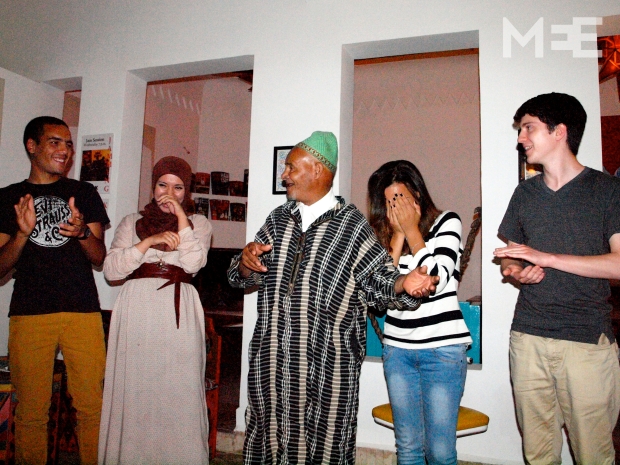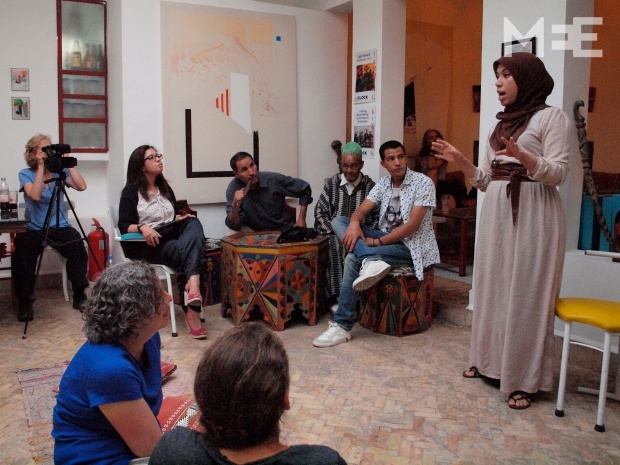Traditional Moroccan storytelling finds new audience at Café Clock in Marrakech
A master storyteller and his apprentices stand before a cheering audience in the main annex of Café Clock in Marrakech. The storytellers have just finished their weekly performance of traditional folk tales.
“Thank you to all of the Moroccans for coming to listen, and thank you especially to the foreigners who are here showing interest in old Moroccan stories,” Haj, the master storyteller, says.
Haj, as Ahmed Ezzarghani is known at Café Clock, began telling stories in 1959 at the age of twenty. Now in his mid-seventies, he wears stylish round glasses and a skull cap far back on his head.
Haj used to tell stories in Jamaa el Fna Square, Marrakech’s famous square and the main stage for the city’s storytellers, but he moved to Café Clock earlier this year to lead their storytelling programme, a new addition to the restaurant’s cultural offerings.
A professional storyteller mentoring newcomers is a rare sight these days. The storytelling programme at Café Clock was initiated partly in response to the rapid disappearance of traditional practitioners in cities across the country. In 2001, UNESCO added Jamaa el Fna to its “Intangible Cultural Heritage of Humanity” list for its high concentration of performers and musicians.
“Storytelling in Jamaa el Fna isn’t happening in the same way anymore,” says Melissa Topacio-Long, the programme’s coordinator. “The stories are told in a way that is maybe less nuanced, and more to attract attention.”
The “halaka”, or circle, refers to the storyteller and his audience, drawn from passers-by whom he entices to stay with the skill and dynamism of his performance. There are fewer and fewer halakat in Jamaa el Fna with each passing year. Television, movies, and the internet now compete for the audience’s attention, while motorised vehicles and numerous juice vendors drown out the storytellers’ voices. Haj is one of the few remaining professional storytellers in Marrakech.
Still, Haj misses the square. “The blender in the kitchen is loud during performances sometimes,” he says.
In his youth, storytellers made a viable income performing in cities throughout Morocco. “Nowadays, a passer-by will listen to your story for one second, say ‘oh I know the story’, and safi [that’s it],” Haj says.
Cultural Exchange Tourism in Marrakech
Café Clock is a Moroccan-Arab-Western fusion restaurant created by British expatriate, Mike Richardson. The first location opened in Fez in 2007; the Marrakech restaurant opened just last year. The Café considers itself a cross-cultural institution, catering to tourists, students and local Moroccans. The annex where Haj and his apprentices perform is decorated with innovative fusion pieces that echo the Café’s mission.
Marrakech enjoys more tourism than any other city in Morocco. It is so famous worldwide, it exists almost as an entity unto itself in the international imagination, a city in isolation. Much of Morocco’s “brand” in the tourist industry has in fact been shaped by Marrakechi novelties, specifically the assortment of spectacles in Jamaa el fna. In the square, one can find snake charmers, monkey handlers, healers, and endless merchants of rugs, leather and metal goods.
This collective and long-term adulation has resulted in radical economic and social changes to the city. Foreigners now own many of the traditional riads (traditional Moroccan building with an interior courtyard or garden) in the old medina, and imported chains like McDonalds and Club Med have popped up within the walls.
Although historically most professional storytellers have been male, Clock’s programme includes apprentices of both genders. “It used to be, and still is in the square, that storytellers are men, not women,” Sara Mouhyeddine, an apprentice, says. It’s a traditional thing... like a woman can never stand in front of men and start gesturing and being self-confident. Even if you want to serve tea to a visitor, you bow your head. So they’re not used to that kind of standing like I do. But I think they like it... all I’ve received so far is good feedback.” Now, she imagines one day performing in Jamaa el Fna.
While Haj performs stories in Moroccan Arabic, the apprentices recite their stories in English for the foreigners in the crowd. “This is to our knowledge the first time the stories have been told in English,” Topacio-Long says.
“What I change are words that are probably not going to fit into other cultures,” Apprentice Mehdi El Ghaly says. “But if I changed the story, I would change the spirit of the Moroccan culture.” Still, the apprentices admit that outside of their highly contextualised form in the Moroccan Arabic dialect, the stories must be altered to make sense in English, especially jokes.
The cultural exchange model of tourism is enjoying growing popularity in Marrakech in response to changing consumer demands. “The major change has been that tourists want to have extraordinary experiences which can only happen through cultural immersion,” Richardson says. “This can be through learning new skills such as calligraphy, cooking couscous or learning the language. Visitors want to return home with unique stories and a deeper understanding of where they have been.”
Paradoxically, UNESCO designation can hasten the degradation of a site, as it has in Petra, by increasing tourist traffic. For “intangible heritage” like storytelling, the threat posed by increased international attention is commodification. By translating the stories into English and shifting the audience to include foreigners, Café Clock risks changing the way the craft is practiced and understood.
Though the apprentices may be the first to perform the folk tales in English, BBC journalist Richard Hamilton published a collection of translated Moroccan stories in 2011 called “The Last Storytellers: Tales from the Heart of Morocco.” He takes umbrage to the suggestion that foreigners are influencing traditional storytelling. “The Café Clock is a great collaboration of Moroccans and other nationalities and it is not a question of 'us and them',” he told Middle East Eye.
Despite the appeal of the cultural exchange model, the result is often the adaptation of local customs for foreign consumers. When asked why the apprentices perform in English rather than French, which is more commonly spoken in the country, Richardson admits that “as an Englishman, Café Clock was always going to be a predominantly Anglophone environment, and selfishly I wanted to fully understand the stories. We are, however, working with the storytellers to also perform in the future in French.”
The Future of Moroccan Storytelling
For the apprentices, the storytelling programme’s foreign audience creates the potential for new types of intercultural interactions: “Maybe a Moroccan who speaks English will sit next to a foreigner and try to explain what Haj is saying, and they form a friendship; you have this exchange,” El Ghaly says. Unlike traditional tourism, locals and foreigners mix in the audience, and the apprentices have the opportunity to shape how they present themselves and their craft to the audience.
Some of the apprentices see the programme as an opportunity to address misconceptions about Moroccans in global media. “Moroccans are Muslims and Arabs, so when someone hears Arabs, they think ‘terrorists’, that’s the first image that people are going to have... but when a foreigner hears your culture in his own words, he is going to appreciate it,” El Ghaly says.
Foreigners’ impressions of Mouhyeddine, who is also a university-level English teacher, are slightly different. “Because I’m veiled, they think I can do nothing. You can’t go to school, you don’t know how to speak English... so they think we’re illiterate girls. [The programme] changed totally how they view us as Muslims, not just Moroccans.”
Storytelling in the square may be on the decline, but an audience remains, if the tradition bends to meet current conditions. “If there is no audience, [the story’s] not going to be famous, even if you repeated it your whole life, because it’s your audience who are going to make you famous, to help your story survive,” El-Ghaly says.
“When I take the story from Haj and I go back home, I tell it to my parents in Darija [Moroccan Arabic],” Mouhyeddine says. “As a Moroccan, I think I’ve learned a lot of things about my own culture, sometimes just small details in the history that I didn’t know; history is your identity. As for foreigners, I think it’s a good thing because we’re giving them something truly traditional in their language.”
The apprentices see themselves as a link in continuing the tradition for future generations. “Storytellers, they are becoming old, becoming weak; since this way is the best way to preserve this kind of art, why not? [Maybe then] other people will preserve it, through the generations,” El Ghaly says. “Haj, he’s giving us the basics of telling a story... if a guy is in the square today, eventually he is going to pass away, so why not ask if he can teach others so that there are a dozen others to take his place.”
“Recently all sorts of different people have been asking me about how to become a storyteller,” Mouhyeddine says.
“A storyteller has stories of your culture,” Haj says. “When you respect him, when you take care of him, you are taking care of your own culture. When a storyteller is dead, a part of your culture is dead.”
Middle East Eye propose une couverture et une analyse indépendantes et incomparables du Moyen-Orient, de l’Afrique du Nord et d’autres régions du monde. Pour en savoir plus sur la reprise de ce contenu et les frais qui s’appliquent, veuillez remplir ce formulaire [en anglais]. Pour en savoir plus sur MEE, cliquez ici [en anglais].






